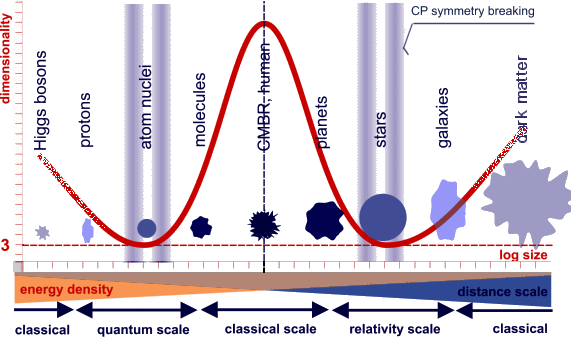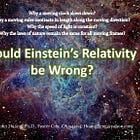Why the speed of light and the theory of ‘Relativity’ are both wrong
Much of modern physics and cosmology will have to be rubbished and new paradigms and mechanically proven concepts created.
(variable light speeds, size, scales, media, note that dark matter does not exist)
False claims
The dogma is that the speed of light travels at a maximum velocity of 186.000 miles per second in vacuo, or only in a vacuum. No vacuum exists anywhere in the universe, so this postulate is false. In reality light travels at different speeds depending on the medium and this upends Relativity and most of modern science. Since we cannot measure anything in a vacuum the claim that there is an upper end to the speed of light is mere speculation. It might be correct, but it could also be completely erroneous and could well vary over time.
It needs to be stated that light is independent of its source and therefore light waves require no medium for their propagation. Light emission is premised on electrons and electrical energy. Light is basically a wave in an electromagnetic field (Faraday, Maxwell), and when this is propagated through a medium (air, water, an object), its speed will vary in accordance with the properties of that medium.
We also know that all wave speeds, like object speeds, must be measured relative to some object on which points A and B can be specified or mapped out. This is called a frame of reference (or a grid map). We can only measure light speed relative to an object on a grid (hence points A and B representing starting and ending points or 2 objects relative to each other).
Logically we cannot measure the speed of light in a vacuum since reference frames and objects don’t exist in vacuo. The speed of light in a vacuum is thereby a theory devoid of meaning. It should also be noted that many scientists don’t believe that the speed of light can even be measured.
“But several physicists have pointed out that while relativity assumes the vacuum speed of light is a universal constant, it also shows the speed can never be measured. Specifically, relativity forbids you from measuring the time it takes light to travel from point A to point B. To measure the speed of light in one direction, you'd need a synchronized stopwatch at each end, but relative motion affects the rate of your clocks relative to the speed of light.” (Koberlein, 2021)
More on this quote below.
We should also emphasise that measuring speed and time is entirely a human invention. It is our conceptions of motion and time which allow calculations of velocity and duration. Time does not exist outside of human consciousness. Therefore time can never be merged with space into a new spatial-duration dimension.
Light speed varies
The history of the speed of light and how it is calculated was posted previously. These measurements are of course incorrect. The speed of light is inconstant and has quite likely varied over universal time. It is however possible that one of Einstein’s insights, namely that time for the cosmos is much longer than that for the Earth might be valid, though difficult to prove. Given that we have never travelled into deep space and it is entirely unlikely that we ever will, we may never know if this intuitive logic is correct.
The Sagnac experiment was also discussed. This is never taught by ‘The Science’ because it disproved the constancy of the speed of light and Relativity. Sagnac’s work has been replicated thousands of times and its effects are used in modern technology. Yet it is ignored because it does not yield the metaphysical conclusions desired by ‘The Science’.
We know that Sagnac was right and Einstein was wrong, because the speed of light relative to a material object, can never be a constant. Sagnac proved that the laws of physics pertaining to the speed of light and all other waves should not be included in the principle of relativity. This is due to the reality that the only frame of reference which is relevant is that of the medium necessary to the production of the light wave. Such frames of reference are not necessarily at rest or in uniform motion, so the principle of relativity does not apply.
In other words, there is no point whatsoever to Einstein’s theory of Relativity. It does not solve a problem, nor does it comport with reality.
Light and Einstein’s hoax
The constancy of the speed of light is fundamental to Relativity and to modern cosmology. Since it is wrong, we know that Relativity and most of modern cosmological physics must be abandoned. This is why it can never be discussed.
The principle of relativity simply means that the laws of physics are equally valid in any frame of reference that is at rest, or in a uniform state of motion. This doesn’t mean that the answers to equations will always be the same, but it means that the equations are valid in all uniformly moving frames of reference and all frames of reference that are at rest. We know, based on what is written above, that this is absolutely false. It also ignores acceleration which Einstein took up in General Relativity and which was missing in Newtonian physics.
In his 1905 manuscript ‘On the Electrodynamics of Moving Bodies’ or ‘Special Relativity’ as it was soon named, the great wizard Einstein used without reference or attribution, the Lorentz ‘transformation equations’, which supposedly showed that the speed of light relative to material objects is a constant. This is the heart of Einstein’s fakery. If we use his own equations, objects in motion must contract in the direction of travel and the units of time must last longer in proportion to speed.
We know that length contraction and time dilation have yet to be proven and would certainly not occur based on Einstein’s own maths. Einstein never provided mechanical and experimental proof for either time dilation or length contraction. It was all a ‘mental exercise’. No proofs have been given for either in the past 100 years.
A key fraud within Relativity is simply this. Einstein believed that the speed of light relative to all objects that are at rest or in uniform motion should be the same (i.e., a constant). To achieve this pre-determined conclusion, he had to manufacture equations which required length contraction and time dilation. There is no other compelling reason for length contraction and time dilation. Einstein’s theory of special relativity is therefore ‘resolving’ a non-existent issue.
In the real world we know that the speed of light is never a constant. Objects and media slow light speed through the interaction of the electric fields of particles with the electric fields of the light wave. This is akin to how gravity slows the passing of a smaller object by a larger object.
Einstein knew this. He comprehended quite well that we must use objects for the measurement of speed. Once objects are used, the speed of light is then relative to the object, not to a vacuum which does not exist. This would make Relativity irrelevant. Einstein eschewed real science and common sense, so desirous was he to prove Relativity and overturn the thousands of experiments which could find no motion of the Earth either diurnally (daily) or through space. Many posts here outline these experiments which are never discussed nor included in ‘education’.
Models and Maths in lieu of reality
In order to mathematically ‘prove’ that the speed of light is constant to all observers in a uniformly moving frame of reference, Einstein had to invent length contraction and time dilation. It was the only way to get the constant result of 186.000 miles per second for the speed of light for all observers in a frame of reference. In other words, it was not deductive logic or mechanical proofs which led to length contraction and time dilation. It was expediency and philosophy which coerced a mathematical solution.
It was this mathematical imperative to prove the a priori, pre-determined conclusion that Lorentz was right. Einstein was desperate to prove that we cannot mechanically measure our planet’s motion because we are moving relative to the Sun, negating a standard frame of reference. Hundreds of light and light-interferometer experiments during the 19th century, including those of Fizeau, and Michelson-Morley had found no movement of the Earth.
This was Einsten’s motivation, which he admits in his own writings. DS Miller and thousands of experiments in the 20th century have confirmed the light-interferometer observations from the 19th century. Movement of this planet cannot be detected. It does not necessarily mean that the Earth is stationary, but it does mean that the mechanical proof of movement is missing.
Bottom Line: ‘The Science’
What Einstein did in his equations, was to force objects in motion to contract and take a second longer in the uniform frame of reference. In reality objects do not contract their length when in motion and time dilation does not exist. Mathematically however, such a forced intervention by Einstein allows an observer in any frame of reference to measure the speed of light to be 186.000 miles per second.
In reality we know that the fundamental premise that all observers must measure the speed of light to be the same in all non-accelerating frames of reference is wrong and irrelevant. There is no reason for this ‘postulate’ other than to forcibly impose ‘relativity’. Einstein’s claim, which distorted time and distance, was obviously unnecessary and has been a perpetual hoax corrupting science and physics for over a hundred years.
==
Some links and sources you shouldn’t read
==Some sources
“There is no way to measure the speed of light in a single direction”, by B. Koberlein, Universe Today, 2021.
“Relativity: The Special and General Theory" Albert Einstein
Available in English
“Spacetime Physics" by Edwin F. Taylor and John Archibald Wheeler
Introduces special relativity in a clear manner
"Special Relativity and Classical Field Theory: The Theoretical Minimum" by Leonard Susskind and Art Friedman
Detailed yet accessible exploration of special relativity and its connections to classical field theory.
The Great Einstein Relativity Hoax and Other Science Questions, Hypotheses, and Improbabilities, Page Truitt, 2021
Retired and former scientist analyses Relativity and its mistakes.
"Faster Than the Speed of Light: The Story of a Scientific Speculation" by João Magueijo
This book presents a dissenting view on certain aspects of relativity, disavowed by the mainstream.







"Time does not exist outside of human consciousness." A perfect observation of reality.
"Therefore time can never be merged with space into a new spatial-duration dimension." Absolutely unavoidable logical conclusion.
Thank you.